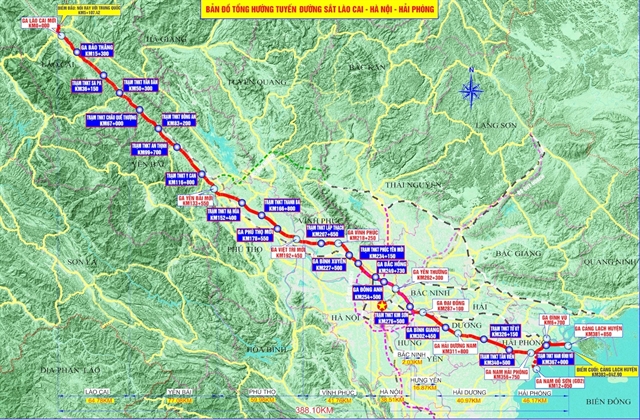 Society
Society

 |
| The map of Lào Cai – Hà Nội – Hải Phòng railway route according to the pre-feasibility report. — Photo chinhphu.vn |
HÀ NỘI — The Government has submitted a proposal requesting the National Assembly (NA) to consider and approve the investment policy for the construction of the Lào Cai – Hà Nội – Hải Phòng railway.
The rail project will span 390.9km with three branch lines totalling about 27.9km, feature a 1,435mm standard gauge, serve both passenger and freight transport, and require a total investment of US$8.369 billion.
According to the Government, the project aims to build a modern and joined up railway system to meet domestic transportation needs and ease international transport between Việt Nam and China.
This will serve as an important driving force for rapid and sustainable socio-economic development.
The project will begin at a rail connection point on the border between the new Lào Cai Station and the North Hekou Station (China) and end at Lạch Huyện Port of Hải Phòng City, passing through nine provinces and cities.
The main route from the new Lào Cai Station to Nam Hải Phòng Station will have a design speed of 160km per hour (kph).
The segment passing through Hà Nội's central hub will have a speed of 120kph, while connection routes and branch lines will be capable of carrying trains at speeds of 80kph.
The route will be studied and selected to ensure the shortest and straightest possible alignment.
Three main structural types will be used along the line including bridges of approximately 29 per cent of the route length, tunnels of around 7 per cent, and ground-level tracks of about 64 per cent.
The entire line is expected to include 18 stations, including three marshalling yards and 15 mixed-use stations.
Additionally, 13 technical operation points will be arranged to support railway operations.
As transport demand increases, some technical operation points may be upgraded to mixed-use stations, and additional stations may be built when needed.
The project will require approximately 2,630ha with more than 19,100 people needing resettlement.
To ensure flexibility and proactivity in use of funding, the Government proposes a combination of financing sources for the project, including central and local government budgets, domestic funding, foreign capital and other legal sources.
The feasibility study report for the project is scheduled to be prepared from 2025, with the goal of basic completion by 2030.
However, the Government's proposal acknowledges that similar railway projects worldwide typically require 36-42 months for preparation, making the target timeline a significant challenge.
Special policies and mechanisms will be needed to accelerate the process.
The Việt Nam Railways Corporation will oversee infrastructure management, maintenance and operation of the entire line. It will also be entrusted with all necessary equipment and vehicles for railway operations.
The Government has also proposed implementing 19 specific policies and mechanisms, including 15 already approved by the NA for the North-South High-Speed Railway Project under Resolution No. 172/2024/QH15. Additionally, the Government suggests introducing four new mechanisms and policies. — VNS




